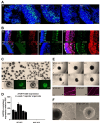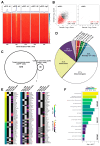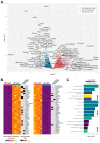Identification and Characterization of ATOH7-Regulated Target Genes and Pathways in Human Neuroretinal Development
- PMID: 38994994
- PMCID: PMC11240604
- DOI: 10.3390/cells13131142
Identification and Characterization of ATOH7-Regulated Target Genes and Pathways in Human Neuroretinal Development
Abstract
The proneural transcription factor atonal basic helix-loop-helix transcription factor 7 (ATOH7) is expressed in early progenitors in the developing neuroretina. In vertebrates, this is crucial for the development of retinal ganglion cells (RGCs), as mutant animals show an almost complete absence of RGCs, underdeveloped optic nerves, and aberrations in retinal vessel development. Human mutations are rare and result in autosomal recessive optic nerve hypoplasia (ONH) or severe vascular changes, diagnosed as autosomal recessive persistent hyperplasia of the primary vitreous (PHPVAR). To better understand the role of ATOH7 in neuroretinal development, we created ATOH7 knockout and eGFP-expressing ATOH7 reporter human induced pluripotent stem cells (hiPSCs), which were differentiated into early-stage retinal organoids. Target loci regulated by ATOH7 were identified by Cleavage Under Targets and Release Using Nuclease with sequencing (CUT&RUN-seq) and differential expression by RNA sequencing (RNA-seq) of wildtype and mutant organoid-derived reporter cells. Additionally, single-cell RNA sequencing (scRNA-seq) was performed on whole organoids to identify cell type-specific genes. Mutant organoids displayed substantial deficiency in axon sprouting, reduction in RGCs, and an increase in other cell types. We identified 469 differentially expressed target genes, with an overrepresentation of genes belonging to axon development/guidance and Notch signaling. Taken together, we consolidate the function of human ATOH7 in guiding progenitor competence by inducing RGC-specific genes while inhibiting other cell fates. Furthermore, we highlight candidate genes responsible for ATOH7-associated optic nerve and retinovascular anomalies, which sheds light to potential future therapy targets for related disorders.
Keywords: ATOH7; CUT&RUN sequencing; RNA sequencing; retinal development; retinal ganglion cells; retinal organoids; retinal progenitor cells; scRNA sequencing.
Conflict of interest statement
The authors declare no conflicts of interest. The funders had no role in the design of the study; in the collection, analyses, or interpretation of data; in the writing of the manuscript; or in the decision to publish the results.
Figures








Similar articles
-
Differentiation of retinal ganglion cells and photoreceptor precursors from mouse induced pluripotent stem cells carrying an Atoh7/Math5 lineage reporter.PLoS One. 2014 Nov 17;9(11):e112175. doi: 10.1371/journal.pone.0112175. eCollection 2014. PLoS One. 2014. PMID: 25401462 Free PMC article.
-
Atonal homolog 7 (ATOH7) loss-of-function mutations in predominant bilateral optic nerve hypoplasia.Hum Mol Genet. 2020 Jan 1;29(1):132-148. doi: 10.1093/hmg/ddz268. Hum Mol Genet. 2020. PMID: 31696227
-
Transcriptome of Atoh7 retinal progenitor cells identifies new Atoh7-dependent regulatory genes for retinal ganglion cell formation.Dev Neurobiol. 2014 Nov;74(11):1123-40. doi: 10.1002/dneu.22188. Epub 2014 May 22. Dev Neurobiol. 2014. PMID: 24799426 Free PMC article.
-
Proneural genes in neocortical development.Neuroscience. 2013 Dec 3;253:256-73. doi: 10.1016/j.neuroscience.2013.08.029. Epub 2013 Aug 30. Neuroscience. 2013. PMID: 23999125 Review.
-
Single-cell RNA sequencing in the study of human retinal organoids.Exp Eye Res. 2025 Jul;256:110417. doi: 10.1016/j.exer.2025.110417. Epub 2025 May 2. Exp Eye Res. 2025. PMID: 40320034 Review.
Cited by
-
Novel ATOH7 mutation and structural characterization in families with optic nerve hypoplasia.Int J Ophthalmol. 2025 Sep 18;18(9):1705-1712. doi: 10.18240/ijo.2025.09.12. eCollection 2025. Int J Ophthalmol. 2025. PMID: 40881441
-
Rescue of Aberrant Splicing Caused by a Novel Complex Deep-intronic ABCA4 Allele.Genes (Basel). 2024 Nov 23;15(12):1503. doi: 10.3390/genes15121503. Genes (Basel). 2024. PMID: 39766771 Free PMC article.
-
Retinal Dystrophy Associated with Homozygous Variants in NRL.Genes (Basel). 2024 Dec 12;15(12):1594. doi: 10.3390/genes15121594. Genes (Basel). 2024. PMID: 39766861 Free PMC article.
References
Publication types
MeSH terms
Substances
Grants and funding
LinkOut - more resources
Full Text Sources

